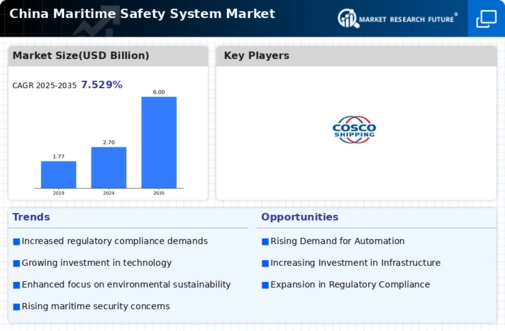Rising Insurance Costs
The maritime safety-system market is also being driven by the rising costs of insurance in the shipping industry. As incidents of maritime accidents increase, insurance premiums have surged, prompting shipping companies to invest in safety systems to mitigate risks. In 2025, it is projected that insurance costs for maritime operations in China will rise by 15%, compelling companies to adopt comprehensive safety measures. This trend suggests that investing in advanced safety systems is not only a regulatory requirement but also a financial necessity for companies aiming to reduce their insurance liabilities. Thus, the maritime safety-system market is likely to see increased demand as businesses seek to enhance their safety protocols.
Increasing Maritime Traffic
The maritime safety-system market in China is experiencing growth due to the rising volume of maritime traffic. As trade routes expand and the demand for shipping services increases, the need for robust safety systems becomes paramount. In 2025, it is estimated that maritime traffic in China will increase by approximately 10%, necessitating enhanced safety measures to mitigate risks associated with higher vessel density. This surge in traffic compels stakeholders to invest in advanced safety technologies and systems, ensuring compliance with safety regulations. Consequently, the maritime safety-system market is likely to see a significant uptick in demand as companies prioritize the implementation of effective safety protocols to protect both human life and cargo.
Growing Environmental Concerns
Environmental sustainability is becoming a critical focus within the maritime sector in China, influencing the maritime safety-system market. With increasing scrutiny on pollution and environmental impact, there is a push for safety systems that also address ecological concerns. The Chinese government has set ambitious targets to reduce maritime emissions by 30% by 2030, which necessitates the integration of safety systems that comply with environmental regulations. This trend indicates a shift towards eco-friendly safety solutions, potentially driving innovation in the maritime safety-system market. Companies that adapt to these environmental standards may find themselves at a competitive advantage, further stimulating market growth.
Government Initiatives and Investments
The Chinese government is actively promoting initiatives aimed at enhancing maritime safety, which is likely to bolster the maritime safety-system market. In recent years, substantial investments have been allocated to improve port infrastructure and safety protocols. For instance, the government has earmarked over $1 billion for safety upgrades in major ports by 2026. These initiatives not only aim to reduce accidents but also enhance the overall efficiency of maritime operations. As a result, the maritime safety-system market is expected to benefit from increased funding and support, leading to the development and deployment of innovative safety solutions that align with national safety objectives.
Technological Integration and Innovation
The integration of advanced technologies into maritime safety systems is a key driver for the market in China. Innovations such as artificial intelligence, big data analytics, and IoT are transforming how safety systems operate. These technologies enable real-time monitoring and predictive analytics, enhancing decision-making processes in emergency situations. By 2025, it is anticipated that the adoption of such technologies will increase by 25% within the maritime safety-system market. This technological evolution not only improves safety outcomes but also streamlines operations, making it a critical factor for companies looking to enhance their safety measures. As a result, the maritime safety-system market is poised for significant growth driven by technological advancements.












Leave a Comment